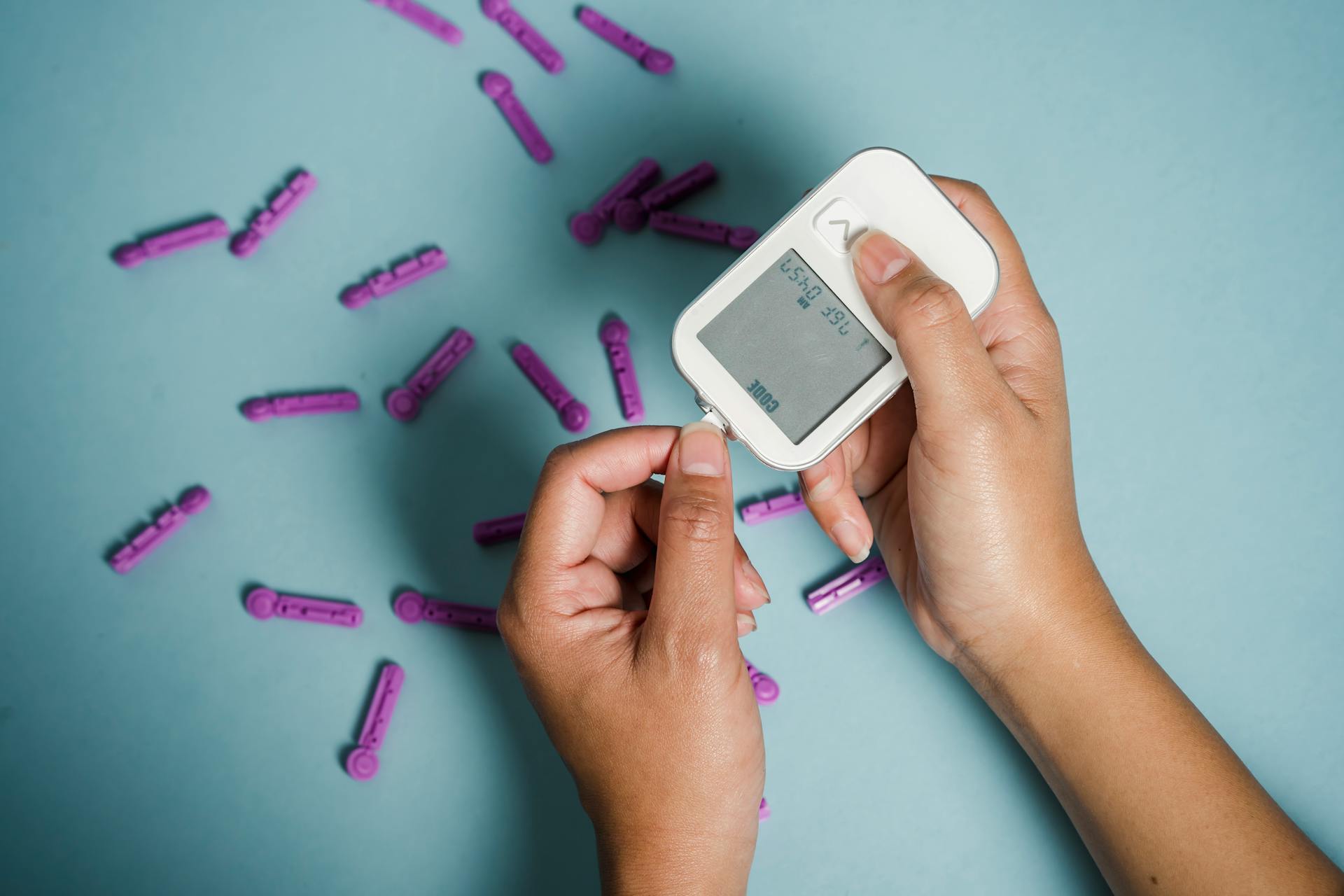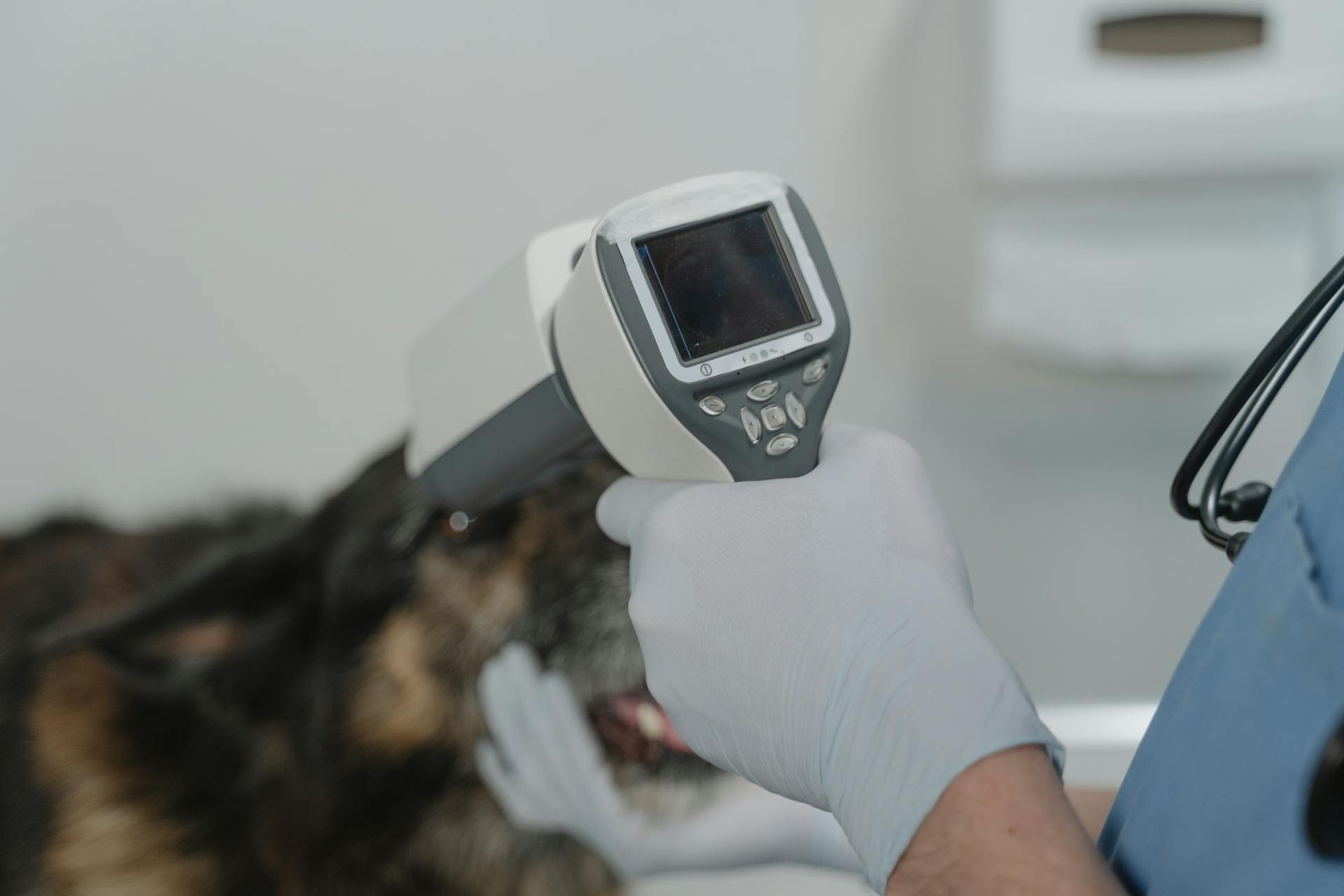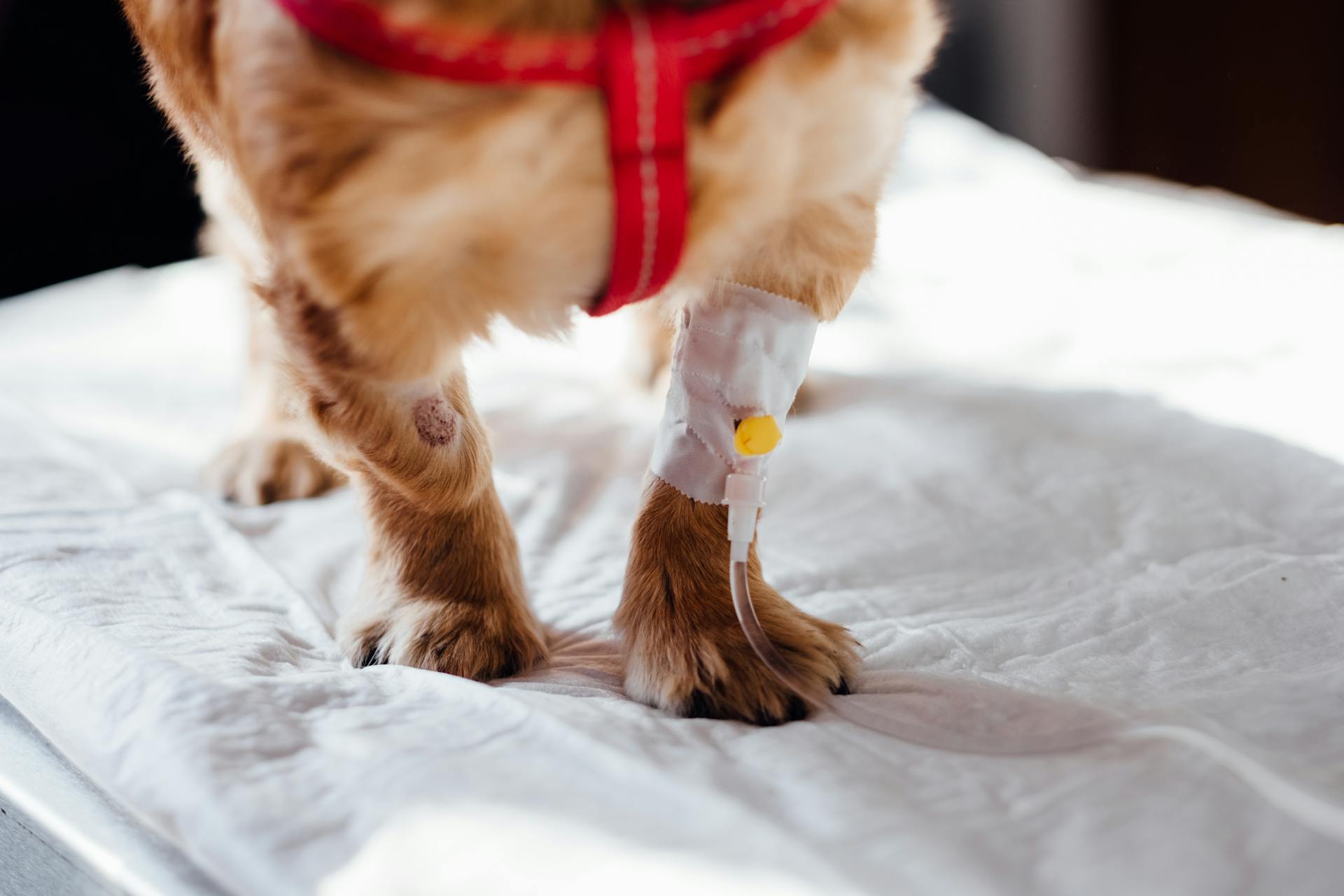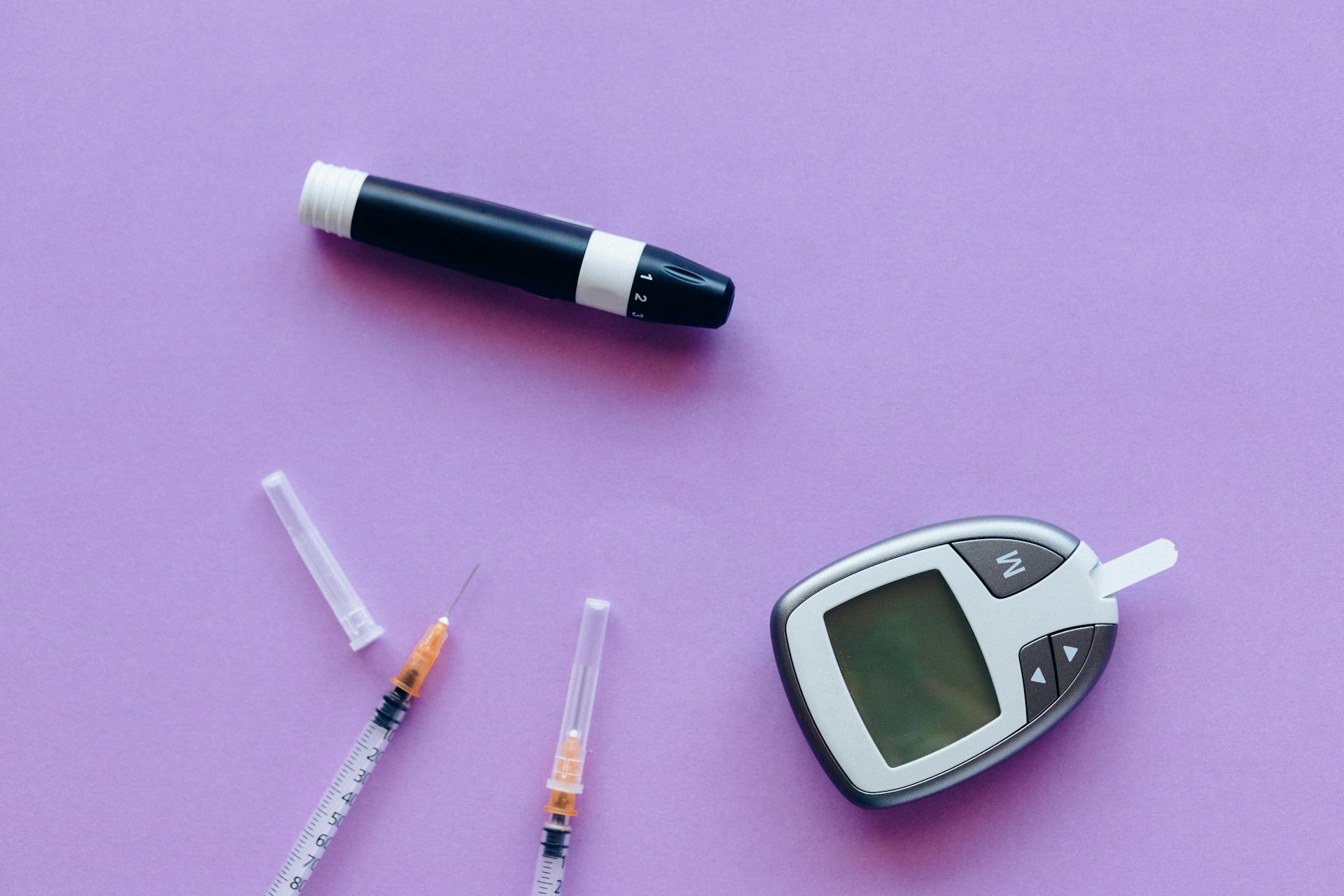
Hypoglycemia in dogs with diabetes is a serious condition that requires prompt attention.
Dogs with diabetes are prone to hypoglycemia due to insulin overdose, which can be caused by overmedication or eating too little food.
Hypoglycemia can occur at any time, even when your dog is on a regular feeding schedule.
Symptoms of hypoglycemia in dogs include shakiness, stumbling, and lethargy, which can progress to seizures and coma if left untreated.
If you suspect your dog is experiencing hypoglycemia, it's essential to act quickly and seek veterinary attention immediately.
The sooner you provide treatment, the better the outcome for your dog.
Diagnosis and Treatment
Your veterinarian will start by examining your dog and taking a medical history to determine the best course of action. They may recommend blood glucose tests to check your dog's blood sugar levels.
A blood glucose test is a simple bedside test that looks at blood sugar levels only. This is often the first step in diagnosing hypoglycemia in dogs.
A fresh viewpoint: Canine Diabetes Diagnosis
Additional testing may be needed, including bloodwork and imaging, such as radiographs/x-rays or abdominal ultrasound, to check for underlying causes of hypoglycemia.
For pets with minimal symptoms, oral liquid glucose may be sufficient, while those with moderate to severe symptoms may require intravenous (IV) fluid therapy with dextrose to help bring their blood sugar up.
Your veterinarian may also recommend intravenous dextrose solution in an emergency, which is essentially concentrated glucose that will quickly cause the blood glucose to rise.
In some cases, your veterinarian may also recommend feeding small frequent meals throughout the day, such as 4 meals per day, to help prevent hypoglycemia in small puppies at risk.
Here's a summary of the initial tests your veterinarian may perform:
- Blood glucose test—a simple bedside test that looks at blood sugar levels only.
- Chemistry/complete blood count—a more in-depth blood test that checks red and white blood cell levels, glucose level, electrolytes, and organ function.
Symptoms
Symptoms of hypoglycemia in dogs can be quite concerning, and it's essential to recognize them early on.
Lack of appetite, or anorexia, is a common symptom of hypoglycemia in dogs.
If your dog is experiencing vomiting, it could be a sign that their body is struggling to regulate its blood sugar levels.

Disorientation, weakness, and "star-gazing" are all symptoms that can be quite alarming, but they're often a sign that your dog is not getting enough energy to their brain.
Tremors and seizures can also occur if your dog's blood sugar levels drop too low.
Fainting, loss of consciousness, and even coma can be life-threatening symptoms of hypoglycemia in dogs.
Here are some common symptoms of hypoglycemia in dogs:
- Lack of appetite (anorexia)
- Lack of energy/lethargy
- Vomiting
- Disorientation/weakness/ “star-gazing”
- Tremors/seizures
- Fainting, loss of consciousness, coma
A Diagnostic Approach
Once hypoglycemia is documented, veterinarians need to rule out spurious causes and determine the underlying cause. They do this by compiling a list of differential diagnoses based on the dog's signalment, history, and physical examination findings.
Preliminary diagnostic tests can provide clues to help narrow down the list of potential causes. For example, if a puppy has gastrointestinal signs, parvovirus should be a top differential for hypoglycemia.
A systematic approach is required if there are no "red flags" to guide the diagnosis. This involves considering all possible causes of hypoglycemia based on the dog's individual characteristics.
Bloodwork and imaging tests, such as radiographs/x-rays or abdominal ultrasound, may be necessary to check for underlying conditions like cancer, liver disease, or adrenal gland disease.
Discover more: What Food Causes Diabetes in Dogs
Treatment

In an emergency, your veterinarian will recommend an intravenous dextrose solution to quickly raise your dog's blood glucose levels.
Applying corn syrup or honey to your dog's oral mucous membranes can be a helpful remedy during a hypoglycemic crisis at home before transporting it to the vet.
Feeding small, frequent meals throughout the day is crucial for small puppies at risk for hypoglycemia, such as Chihuahua puppies, to prevent episodes.
For pets with minimal symptoms, oral liquid glucose may be sufficient to treat hypoglycemia.
For your interest: Merrick Dog Food for Small Dogs
Prevention and Management
For diabetic dogs, routine glucose monitoring after insulin administration is necessary. This may be done at home or in your vet's office.
Monitoring your dog's glucose levels regularly is crucial to preventing hypoglycemia. Patients with underlying disease processes should be monitored frequently at their vet's office.
Feeding your dog a high-quality diet in small, frequent meals can help regulate their glucose levels, especially for puppies and toy breeds.
Recovery and Management
Recovery from hypoglycemia in dogs can be swift, especially for mild uncomplicated cases where frequent small meals high in fats, protein, and complex carbohydrates are recommended.
Monitoring pets to ensure they're eating is crucial to recovery, especially for toy breeds and puppies.
Pets with moderate-to-severe or complex hypoglycemia may require hospitalization, and recovery is guarded.
Treatment of the underlying cause of hypoglycemia is often necessary, which may involve adjusting insulin dosage for diabetic dogs.
Administering an intravenous dextrose solution and/or oral prednisone is a common treatment for hypoglycemia.
Most dogs can make a full recovery from hypoglycemia with proper veterinary care, but left untreated, it can lead to seizures or even death.
Intriguing read: Diabetes Insipidus in Dogs Treatment Cost
Prevention
Prevention is key to managing various conditions in dogs. Routine glucose monitoring after insulin administration is necessary for diabetic dogs.
For diabetic dogs, this may be done at home or in your vet’s office. Small, frequent meals can help keep glucose levels regulated in puppies and toy breeds.
Ensuring these pets are eating a high-quality diet is crucial to prevent hypoglycemia. Patients with underlying disease processes should be monitored frequently at their vet’s office.
Consider reading: Vets Dog Treats
Feeding a Dog Sugar Water
Feeding a dog sugar water is not a straightforward task. You can give your dog sugar water, but it's essential to know when to do so.
Recommended read: Blood Sugar Levels for Dogs with Diabetes
During a hypoglycemic episode, it's better to administer corn syrup or honey onto the gums before bringing your dog to the veterinarian. This can help stabilize your dog's blood sugar levels temporarily.
You should only give your dog sugar water if you're in a pinch and can't get to a veterinarian right away.
Exertional
Exertional hypoglycemia can occur in dogs, especially those that are lean and engage in intense exercise or prolonged physical activity.
This phenomenon is often referred to as "hunting or working dog hypoglycemia" due to its prevalence in dogs that participate in such activities.
Continuous exercise for 2 to 3 hours at 65% maximal oxygen uptake can lead to hypoglycemia in humans, making it more than conceivable that it would happen in dogs under similar conditions.
Extreme exercise coupled with poor body condition can increase the risk of hypoglycemia in dogs.
Well-conditioned working dogs participating in routine field and search and rescue activities are unlikely to develop hypoglycemia.

Hunting dog hypoglycemia should be considered in dogs with an appropriate signalment and history, but it's a diagnosis of exclusion, and other differentials for hypoglycemia should always be considered.
A case report highlighted the importance of considering secondary causes of hypoglycemia, such as hypoadrenocorticism, which was found to be the underlying cause of hypoglycemia in a hunting dog with recurring seizures associated with exercise.
You might like: Best Dog Food for Hunting Hounds
Insulin and Medication
Insulin and Medication is a crucial aspect to consider when managing hypoglycemia in dogs with diabetes.
Only use the Insulin prescribed by your veterinarian, and do not change the dosage or schedule without consulting them first.
If you've never given an Insulin injection before, it's essential to get proper instruction from your pet's health care professional to avoid any complications.
Insulin for pets should always be refrigerated to maintain its potency.
Opened Insulin should be discarded after 30 days, regardless of the expiration date, to ensure your pet's safety.
Consider reading: Dog Insulin Types
Understanding Diabetes
Diabetes is a chronic condition that affects how the body regulates blood sugar levels. It's caused by a lack of insulin, a hormone produced by the pancreas that helps glucose enter cells.
There are two main types of diabetes: Type 1 and Type 2. Type 1 diabetes is an autoimmune disease that destroys insulin-producing cells in the pancreas, while Type 2 diabetes is a metabolic disorder that affects the body's ability to use insulin.
In dogs, diabetes is often caused by a combination of genetics and obesity, which can lead to insulin resistance and a decrease in insulin production.
Consider reading: Dog Names for 2 Dogs
Causes
Diabetes in dogs can be a complex condition, but understanding its causes can help you take better care of your furry friend. Low blood sugar, also known as hypoglycemia, can be a serious issue for diabetic dogs.
There are four main categories of issues that can contribute to a dog's blood sugar dropping lower than normal: poor dietary intake of glucose or glucose-making molecules, increased glucose demand, insufficient utilization of or the inability to make body stores of energy molecules, and endocrine-system abnormalities causing hormonal imbalances.
A dog's blood sugar level is maintained within a narrow range, typically between 3.3 mmol/L to 6.2 mmol/L or 60 mg/dL to 111 mg/dL. Hypoglycemia occurs when this range is disrupted, and glucose concentration falls below 3.3 mmol/L or 60 mg/dL.
The four mechanisms by which hypoglycemia may arise are:
- Poor dietary intake of glucose and other substrates used in hepatic gluconeogenesis
- Increased glucose uptake and utilization by normal or neoplastic cells due to an increase in demand or secondary to hyperinsulinism
- Dysfunctional hepatic glycogenolytic or gluconeogenic pathways
- Endocrine abnormalities resulting in a deficiency of counter-regulatory hormones such as cortisol
Insufficient utilization of or the inability to make body stores of energy molecules can also lead to hypoglycemia. This can be due to various factors, including poor dietary intake or increased glucose demand.
Blood Glucose Meter
Blood Glucose Meters are used to check the pet's blood glucose levels, but be aware that some meters require large samples of blood, which can be difficult to obtain from pets.
The same meter used for humans can be used for pets, but it's essential to make a wise choice considering the cost of the meter itself.
Blood Glucose Meters are an expensive item, so it's crucial to factor in the cost of the test strips for the meter when making your decision.
The test strips for the meter can add up quickly, so be sure to read the instructions carefully and make sure the meter is properly calibrated with each new box of strips.
This will help ensure accurate readings and avoid any potential issues with the meter.
For your interest: Diabetic Service Dog Cost
Sources
- https://www.vetlexicon.com/canis/internal-medicine/articles/hypoglycemia/
- https://www.safarivet.com/care-topics/dogs-and-cats/diabetes/rapid-insulin-metabolism/
- https://www.ncbi.nlm.nih.gov/pmc/articles/PMC5949948/
- https://www.kingsdale.com/hypoglycemia-in-dogs
- https://www.petmd.com/dog/conditions/systemic/hypoglycemia-dogs
Featured Images: pexels.com


